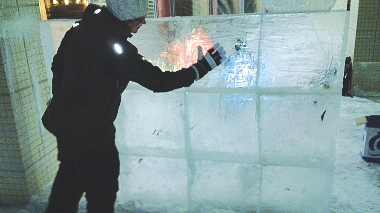 诺基亚发明冰制触摸屏 infrared 红外线的 emitter 发射器 ubiquitous 到处存在的 sculpt 雕刻 blast 吹风 Researchers from the Nokia Research Center in Tampere, Finland, have turned a wall of ice into a huge interactive touchscreen display. Using infrared* emitters* and detectors to determine hand location and movement, the team projected images onto the blocks of ice so that users could see flames behind their hands. Happily, users didn't need to worry about catching a chill from icy fingers as the setup managed to keep track of gloved as well as ungloved hands. The Nokia research team decided to use a resource in plentiful supply to demonstrate the principle of ubiquitous* computing – where computers are embedded into everyday objects such as tables, walls or doors. They contracted a local company to collect a metric ton of 25 cm thick river ice and then cut out 50 cm square blocks using a chainsaw and ice sculpting* tools. These blocks were assembled into a 2 x 1.5 m wall of ice, applying water or snow at the joints. The front surface was then blasted* with a heat gun – like the ones used to strip paint – to provide a smooth, uniform tactile interface for the multi-touch display. Behind the wall, the researchers pointed near-infrared light illuminators toward the wall and then positioned an array of infrared cameras pointing through the ice to focus on the front surface. Anyone placing a hand on the front of the ubiquitous ice – or Ubice – surface caused light to reflect towards the camera array and a computer translated the signals from each camera in the array into the precise location, size and motion of the hand. The computer then sent the results to a projector where such things as flames were made to appear beneath the user's hand. There was a concern that the heat from the 2000 ANSI lumen projector would melt the ice but the outside temperature of -15 degrees Celsius managed to keep the wall intact. The system was found to work best with bare hands but still managed to keep track of gloved users, although some sensitivity issues were experienced. The installation managed to attract participation from passers-by, who provided positive feedback to the team. Still asking yourself why? Apart from the obvious "why not?" NRC Tampere researchers are tasked to explore novel interface, software and multimedia solutions. The team's Jyri Huopaniemi explained that "this was a playful experiment, but one that we think showed interactive computing interfaces can now be built anywhere." | 
